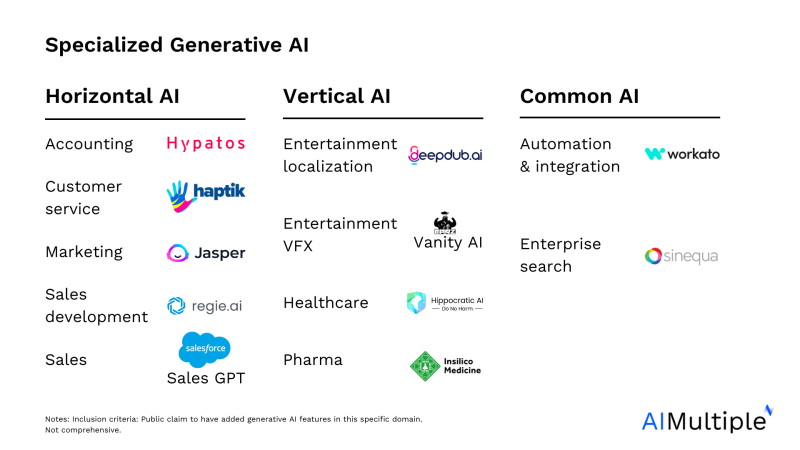“The Rise of Specialized Silicon: Exploring the Landscape of AI Hardware
Artikel Terkait The Rise of Specialized Silicon: Exploring the Landscape of AI Hardware
- Federated Learning: Training AI Without Sharing Data
- The Rise Of The Specialized: Diving Deep Into The World Of AI Chips
- Progressive Web Apps: The Future Of Web Experiences
- The Rise Of The Edge: Exploring The Power Of On-Device Machine Learning
- Decoding Emotions: A Deep Dive Into Sentiment Analysis
Table of Content
Video tentang The Rise of Specialized Silicon: Exploring the Landscape of AI Hardware
The Rise of Specialized Silicon: Exploring the Landscape of AI Hardware

Artificial intelligence (AI) is rapidly transforming industries, from healthcare and finance to transportation and entertainment. This revolution is fueled not only by sophisticated algorithms and massive datasets but also by a new generation of specialized hardware designed to accelerate AI workloads. Traditional CPUs, while versatile, struggle to keep pace with the computationally intensive demands of modern AI. This has spurred the development of dedicated AI hardware, optimized for specific tasks like deep learning inference and training. This article explores the diverse landscape of AI hardware, examining different architectures, key players, challenges, and future trends.
The Need for Specialized AI Hardware
The core of AI, particularly deep learning, relies on artificial neural networks (ANNs). These networks consist of interconnected nodes (neurons) organized in layers, processing data through complex mathematical operations, primarily matrix multiplications and additions. Training these networks involves iteratively adjusting the connection weights between neurons, a process requiring immense computational power. Inference, the process of using a trained network to make predictions on new data, also demands significant computational resources.
Traditional CPUs, designed for general-purpose computing, are not inherently optimized for these types of operations. They excel at handling a variety of tasks, but their sequential processing nature limits their efficiency when dealing with the highly parallel nature of neural network computations. This limitation leads to bottlenecks, increased latency, and higher energy consumption, hindering the widespread adoption of AI.
Key Architectures in AI Hardware
Several specialized hardware architectures have emerged to address the limitations of CPUs and accelerate AI workloads. These include:
-
Graphics Processing Units (GPUs): Originally designed for rendering graphics, GPUs have become a workhorse for AI, particularly deep learning. Their massively parallel architecture, consisting of thousands of cores, allows them to perform matrix operations much faster than CPUs. Companies like NVIDIA and AMD dominate the GPU market, constantly innovating to enhance their performance for AI applications. GPUs are widely used for both training and inference, especially in cloud environments.
-
Field-Programmable Gate Arrays (FPGAs): FPGAs are integrated circuits that can be reconfigured after manufacturing. This flexibility allows developers to customize the hardware architecture to perfectly match the specific requirements of their AI models. FPGAs offer a good balance between performance and power efficiency, making them suitable for edge computing applications where resources are constrained. Companies like Xilinx (now part of AMD) and Intel are key players in the FPGA market.
-
Application-Specific Integrated Circuits (ASICs): ASICs are custom-designed chips tailored to a specific application. In the context of AI, ASICs are designed to execute specific AI algorithms with maximum efficiency. This specialization results in superior performance and energy efficiency compared to GPUs and FPGAs. However, ASICs lack the flexibility of other architectures, making them less adaptable to new algorithms or changing model requirements. Companies like Google (with its Tensor Processing Units or TPUs), Amazon (with its Inferentia and Trainium chips), and Tesla (with its custom AI chips for autonomous driving) have developed ASICs for their specific AI needs.

-
Neuromorphic Computing: Inspired by the structure and function of the human brain, neuromorphic computing aims to create hardware that mimics biological neural networks. These chips use spiking neural networks and event-driven processing, offering the potential for ultra-low power consumption and real-time processing. While still in its early stages, neuromorphic computing holds promise for applications like robotics, sensor processing, and edge AI. Intel (with its Loihi chip) and IBM (with its TrueNorth chip) are pioneering efforts in this field.


The Competitive Landscape: Key Players and Their Strategies
The AI hardware market is highly competitive, with established companies and emerging startups vying for dominance. Here’s a brief overview of some key players and their strategies:
-
NVIDIA: The undisputed leader in the GPU market, NVIDIA has successfully leveraged its expertise in graphics processing to become a major force in AI. Their GPUs are widely used for both training and inference, and they offer a comprehensive software ecosystem (CUDA) that makes it easy for developers to program their hardware.
-
AMD: A strong competitor to NVIDIA in the GPU market, AMD is also making significant strides in AI hardware. Their GPUs offer competitive performance and are increasingly being adopted for AI applications.
-
Intel: A long-standing player in the CPU market, Intel is expanding its presence in AI hardware with its CPUs, GPUs, FPGAs, and neuromorphic chips. They offer a diverse portfolio of solutions catering to different AI workloads.
-
Google: Google has developed its own TPUs, ASICs specifically designed for accelerating their AI models. TPUs are used extensively within Google’s data centers and are also available to cloud customers through Google Cloud Platform (GCP).
-
Amazon: Amazon has also developed its own AI chips, Inferentia for inference and Trainium for training. These chips are designed to optimize the performance and cost-effectiveness of AI workloads on Amazon Web Services (AWS).
-
Tesla: Tesla has developed custom AI chips for its autonomous driving systems. These chips are designed to process sensor data in real-time and enable autonomous navigation.
-
Startups: Numerous startups are also entering the AI hardware market with innovative architectures and solutions. These startups often focus on specific niches, such as edge AI or low-power AI.
Challenges and Future Trends
The development and deployment of AI hardware face several challenges:
-
Cost: Specialized AI hardware can be expensive, particularly ASICs. This cost can be a barrier to entry for smaller companies and researchers.
-
Complexity: Programming and deploying AI models on specialized hardware can be complex, requiring specialized skills and tools.
-
Flexibility: ASICs, while highly efficient, lack the flexibility of GPUs and FPGAs. This can be a disadvantage when dealing with evolving AI algorithms and model architectures.
-
Power Consumption: AI workloads can be power-hungry, especially during training. Reducing power consumption is crucial for deploying AI in edge devices and data centers.
Despite these challenges, the future of AI hardware looks promising. Key trends include:
-
Continued Innovation in Architectures: Researchers and engineers are constantly exploring new architectures and techniques to improve the performance and efficiency of AI hardware.
-
Edge AI: The deployment of AI models on edge devices (e.g., smartphones, cameras, sensors) is driving the development of low-power, high-performance AI hardware optimized for resource-constrained environments.
-
Heterogeneous Computing: Combining different types of hardware (e.g., CPUs, GPUs, FPGAs, ASICs) in a single system to optimize performance for specific AI workloads.
-
Software-Hardware Co-design: Designing AI algorithms and hardware architectures together to maximize efficiency and performance.
-
Open Source Hardware: The rise of open-source hardware platforms is fostering innovation and collaboration in the AI hardware community.
Conclusion:
AI hardware is a critical enabler of the AI revolution. Specialized architectures like GPUs, FPGAs, and ASICs are essential for accelerating AI workloads and enabling new applications. The AI hardware market is highly competitive, with established companies and emerging startups vying for dominance. While challenges remain, ongoing innovation and the rise of edge AI are driving the development of more efficient, powerful, and versatile AI hardware solutions. As AI continues to evolve, specialized hardware will play an increasingly important role in shaping its future.
FAQ: AI Hardware
Q1: What is the difference between a CPU and a GPU in the context of AI?
A: CPUs are general-purpose processors designed for a wide range of tasks, executing instructions sequentially. GPUs, originally designed for graphics rendering, have a massively parallel architecture with thousands of cores, making them much more efficient for matrix operations, which are fundamental to AI, particularly deep learning.
Q2: What are the advantages and disadvantages of using ASICs for AI?
A: Advantages: ASICs are custom-designed chips optimized for specific AI algorithms, resulting in superior performance and energy efficiency. Disadvantages: They lack flexibility, making them less adaptable to new algorithms or changing model requirements, and they are expensive to develop.
Q3: What is Edge AI, and why is it important?
A: Edge AI refers to running AI models on devices at the edge of the network (e.g., smartphones, cameras, sensors) rather than in the cloud. It’s important because it reduces latency, improves privacy, and enables real-time processing in resource-constrained environments.
Q4: What is neuromorphic computing, and what are its potential applications?
A: Neuromorphic computing is a type of computing that mimics the structure and function of the human brain. It uses spiking neural networks and event-driven processing, offering the potential for ultra-low power consumption and real-time processing. Potential applications include robotics, sensor processing, and edge AI.
Q5: What are the key challenges facing the AI hardware industry?
A: Key challenges include the high cost of specialized AI hardware, the complexity of programming and deploying AI models on these platforms, the lack of flexibility in ASICs, and the high power consumption of AI workloads.
Q6: What is the role of software in AI hardware?
A: Software plays a crucial role in AI hardware. Optimized software libraries, compilers, and frameworks are essential for efficiently utilizing the capabilities of specialized hardware and simplifying the development process. Software-hardware co-design is becoming increasingly important for maximizing performance.
Q7: How are FPGAs used in AI?
A: FPGAs are used in AI because their reconfigurable architecture allows them to be customized to specific AI model requirements. This provides a balance between performance and flexibility, making them suitable for edge computing and other applications where adaptability is important.
Q8: What is heterogeneous computing in the context of AI?
A: Heterogeneous computing involves using different types of processors (CPUs, GPUs, FPGAs, ASICs) in a single system to optimize performance for specific AI tasks. Each processor is assigned the tasks it is best suited for, resulting in improved overall efficiency.
Q9: What is the impact of AI hardware on the environment?
A: The development and use of AI hardware can have a significant environmental impact due to the energy consumption of data centers and the manufacturing process of the chips. Efforts are being made to develop more energy-efficient hardware and reduce the environmental footprint of AI.
Q10: Are there open-source AI hardware initiatives?
A: Yes, there are several open-source AI hardware initiatives aimed at fostering innovation and collaboration in the field. These initiatives provide open-source hardware designs, software tools, and educational resources for researchers and developers.
Conclusion:
The specialized hardware landscape for AI is rapidly evolving, driven by the insatiable demands of increasingly complex and sophisticated AI models. From the established dominance of GPUs to the promise of neuromorphic computing and the tailored efficiency of ASICs, the options are diverse and continuously expanding. The challenges of cost, complexity, and power consumption are being actively addressed through innovative architectures, software optimization, and a growing emphasis on edge computing. As AI permeates every aspect of our lives, the critical role of specialized hardware in enabling its potential will only continue to grow in importance, shaping the future of technology and beyond.
